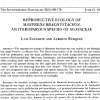
Autores:
Eguiarte, L. E.
A. Búrquez
Revista y/o libro:
The Southwestern Naturalist
Volumen:
32: 169‑178.
Año:
1987
Sinopsis:
The reproductive ecology of Manfreda brachystachya was studied at the Pedregal de San Angel Preserve, in Mexico City. The floral characteristics of M. brachystachya are consistent with bat pollination, and the main pollinator was the Little Long-nosed bat (Leptonycteris sanborni Phyllostomatidae). Other bats, hawkmoths, and hummingbirds were minor pollinators, while perching birds and bees robbed nectar. The flowers were open for several days; nectar production was greatest during the first night and decreased with age. First day flowers were "male," and the two following days they were "female". The flowers were self-compatible but were not autogamous due to dichogamy and spatial separation. Two sites with similar numbers of plants but contrasting numbers of inflorescences were studied. Where inflorescences were dense, leaf rosettes were smaller, but fruit set was higher.